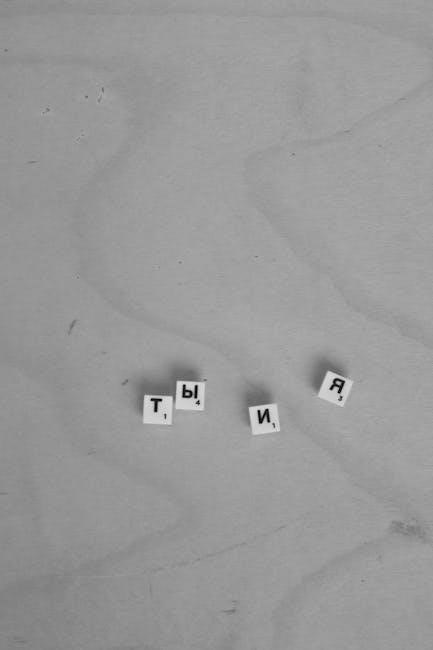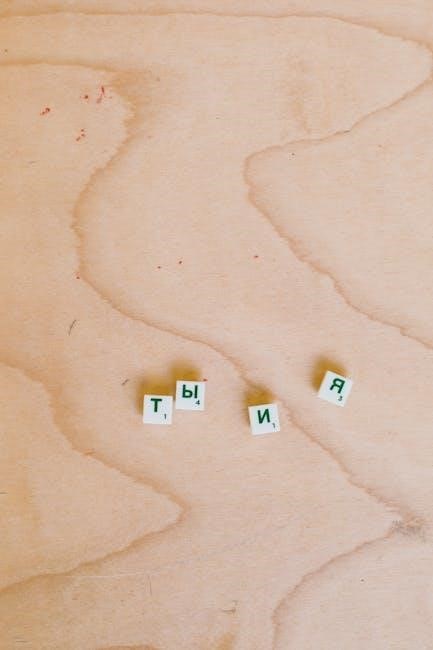The Spanish alphabet, or el abecedario, consists of 27 letters, including vowels and consonants. It is a foundational tool for learning Spanish pronunciation and grammar. Downloadable PDF guides provide comprehensive resources for mastering the alphabet, vowels, and consonants, making it easier for learners to practice and understand the language effectively.
1.1 What is the Spanish Alphabet?
The Spanish alphabet, known as el abecedario, consists of 27 letters. It includes the 26 letters of the English alphabet plus the additional letter ñ. Spanish vowels (a, e, i, o, u) and consonants make up the core of the alphabet. Accented letters like á, é, í, ó, ú are also part of the system but are not considered separate letters. The Spanish alphabet is phonetic, meaning each letter has a consistent sound, making pronunciation predictable once the rules are learned. This structure simplifies learning and ensures clarity in communication. PDF guides and pronunciation charts are widely available to help learners master the alphabet effectively.
1.2 Historical Background of the Spanish Alphabet
The Spanish alphabet has its roots in the Latin script, inherited from the Romans. Over centuries, it evolved, incorporating influences from Arabic during the Moorish occupation of the Iberian Peninsula. The modern Spanish alphabet was formalized in 2010 by the Real Academia Española, which added the letter ch and ll as distinct letters. Historically, the Spanish alphabet included additional letters like ç and g̃, but these were later dropped. Today, it consists of 27 letters, including ñ, which is unique to Spanish. This evolution reflects the linguistic and cultural richness of the Spanish language. PDF guides often include historical notes to enhance understanding.
1.3 Importance of Learning the Spanish Alphabet
Mastering the Spanish alphabet is essential for developing strong language skills. It provides the foundation for correct pronunciation, spelling, and comprehension. Each letter has a consistent sound, unlike English, making it easier to read and write once learned. Understanding the alphabet helps learners recognize patterns in words and phrases, enhancing overall language acquisition. Additionally, it enables access to various educational resources, such as PDF guides and audio tools, which are widely available online. By focusing on the alphabet, learners build a solid base for advancing in Spanish, ensuring clear communication and cultural connection.

Spanish Alphabet and Pronunciation Guide
This section provides a clear guide to the pronunciation of each letter in the Spanish alphabet, covering vowels, consonants, and special sounds. It emphasizes consistent pronunciation rules, aiding language acquisition and fluency. Downloadable PDF guides and audio resources are available to enhance learning.
2.1 Vowels in the Spanish Alphabet
The Spanish alphabet includes five primary vowels: A, E, I, O, U. Each vowel has a consistent pronunciation, making them easier to learn. The letter A is pronounced like “ah,” as in “father.” E sounds like “eh,” similar to “get.” I is pronounced “ee,” like “see,” while O is “oh,” as in “go.” Lastly, U is pronounced “oo,” like “boot.” These vowels are shorter and crisper than their English counterparts. Understanding their sounds is crucial for accurate pronunciation. Downloadable PDF guides and audio resources provide further practice to master these essential vowel sounds effectively.
2.2 Consonants in the Spanish Alphabet
The Spanish alphabet includes 22 consonants, each with distinct sounds. Letters like B, C, D, F, M, N, P, Q, S, T, V, W, X, Y, Z are part of the set. Unique to Spanish are CH (pronounced like “ch” in “church”) and LL (pronounced like “y” in “yes”). Most consonants are pronounced similarly to their English counterparts, but some, like B and V, have softer sounds. The letter W is rare and typically appears in foreign words. Downloadable PDF guides and charts provide clear visuals and pronunciation tips for mastering these consonants effectively.
2.3 Special Letters and Sounds
The Spanish alphabet includes special letters and sounds that differ from English. The letter Ñ (eñe) is unique to Spanish, pronounced like “ny” in “canyon.” The CH is pronounced as in “church,” while LL sounds like the “y” in “yes.” The letter H is always silent, unlike in English. Additionally, the RR is rolled, creating a distinct sound. These special letters and sounds are crucial for accurate pronunciation. Downloadable PDF guides and pronunciation charts provide detailed audio and visual aids to help learners master these unique aspects of the Spanish alphabet effectively.

Spanish Vowel Pronunciation
Spanish vowels (A, E, I, O, U) have consistent pronunciation. A sounds like “ah,” E like “eh,” I like “ee,” O like “oh,” and U like “oo.” Downloadable PDF guides provide detailed vowel pronunciation charts.
3.1 Pronunciation of A
The letter A in Spanish is pronounced as “ah,” similar to the “a” in the English word “father.” This sound is consistent and clear, with no variation in pronunciation. Whether at the beginning, middle, or end of a word, A always maintains its distinct “ah” sound. For example, in words like casa (house) or amigo (friend), the pronunciation of A remains the same. Downloadable PDF guides and pronunciation charts often highlight this consistency, making it easier for learners to practice and master the sound of A in Spanish.
3.2 Pronunciation of E
The letter E in Spanish is pronounced as “eh,” similar to the “e” in the English word “get.” This sound is consistent and does not vary based on the word’s position. For example, in words like cena (dinner) or bebé (baby), the E is pronounced clearly as “eh.” Unlike in English, the E in Spanish is never silent and always retains its distinct sound. Downloadable PDF guides and audio resources often emphasize this consistency, helping learners master the pronunciation of E effectively. This clarity makes it easier to practice and use in everyday conversation.
3.3 Pronunciation of I
The letter I in Spanish is pronounced as “ee,” similar to the “ee” in the English word “see.” This sound is crisp and consistent, with no variation in pronunciation. For example, in words like cine (movie theater) and vivir (to live), the I is pronounced clearly as “ee.” This consistency makes it easier for learners to master the sound. Downloadable PDF guides and audio resources often highlight this pronunciation, providing learners with practical tools to practice and perfect the sound of I in various contexts. This clarity aids in effective communication.
3.4 Pronunciation of O
The letter O in Spanish is pronounced with a clear, open sound, similar to the “o” in the English word “go.” Unlike English, however, the Spanish O does not vary in pronunciation and remains consistent in all contexts. For example, in words like oso (bear) or como (I eat), the O is pronounced as “oh.” This consistency makes it easier for learners to master. Downloadable PDF guides and audio resources often provide practice exercises to perfect the pronunciation of O, ensuring learners can confidently use it in everyday conversations. This clarity enhances overall Spanish language proficiency.
3.5 Pronunciation of U
The letter U in Spanish is pronounced similarly to the “u” in the English word “boot,” but with a shorter and crisper sound. In most cases, U is pronounced like “oo” in “moon,” as in words like uno (one) or tú (you). However, when U follows the letter G, such as in guerra (war), it produces a “w” sound, like in “water;” This unique pronunciation rule is essential for mastering Spanish. Downloadable PDF guides and audio resources often include exercises to practice the correct pronunciation of U, helping learners improve their speech clarity and accuracy.

Spanish Consonant Pronunciation
Spanish consonants are generally similar to English but with some key differences. Letters like C and Z have distinct regional pronunciations, while B and V sound alike. The letter H is always pronounced.
4.1 Consonants with Similar Pronunciation to English
Many Spanish consonants are pronounced similarly to their English counterparts. Letters like B, C (before E or I), D, F, M, N, P, Q (before U), S, T, and V sound the same as in English. For example, the letter B is pronounced like the B in “boy,” and F sounds like the F in “fox.” This similarity makes these consonants easier for English speakers to learn. However, some letters like C and Z have different pronunciations in certain regions, such as a lisp-like “th” sound in Spain.
4.2 Consonants with Different Pronunciation
Some Spanish consonants have distinct pronunciations compared to English. The letter G sounds like the g in “great” before A, O, U, or consonants but has a guttural Spanish consonants have unique pronunciation rules in certain cases. The digraph LL is pronounced like the Access comprehensive Spanish Alphabet PDF guides, interactive pronunciation tools, and audio resources to improve your Spanish skills. These materials help learners master the alphabet and pronunciation effectively. Download them for offline practice anytime, anywhere, and enhance your language learning journey with these valuable tools designed for all levels. Free Spanish Alphabet PDF guides are essential tools for learners, offering a clear and structured approach to mastering the alphabet. These guides typically include the 27 letters, their names in Spanish, and a pronunciation key. Many PDFs provide visual representations, making it easier to associate each letter with its sound. For example, the letter “A” is pronounced like “ah,” as in “casa,” while “E” sounds like “eh,” as in “cena.” Some guides also include interactive elements, such as pronunciation exercises and quizzes, to help reinforce learning. Additionally, downloadable PDFs often feature example words for each letter, aiding in memorization. These resources are widely available online and are designed to be user-friendly, catering to both beginners and advanced learners. By using these guides, students can practice offline and develop a strong foundation in Spanish pronunciation and alphabet recognition. Interactive Spanish alphabet tools offer engaging ways to learn the language. These tools often include clickable letters, quizzes, and pronunciation exercises. Some tools feature flashcards with audio clips, allowing users to hear native speaker pronunciations. Interactive PDF guides are also popular, providing a hands-on approach to learning. Many tools include games and activities to test knowledge of vowels, consonants, and special sounds. These resources are designed for self-paced learning, making them ideal for beginners and advanced learners alike. By incorporating interactive elements, these tools enhance retention and make learning the Spanish alphabet a fun and dynamic experience. Spanish alphabet audio resources are essential for mastering pronunciation. These resources often include MP3 files or audio clips that provide native speaker recordings of each letter. Learners can hear the correct pronunciation of vowels, consonants, and special sounds. Many audio guides are paired with downloadable PDFs, allowing users to follow along visually while listening. This combination helps develop both visual and auditory recognition of the Spanish alphabet. Audio resources are particularly useful for self-study, enabling learners to practice pronunciation anywhere. They are widely available online and often free, making them accessible to anyone looking to improve their Spanish language skills effectively. Mastering the Spanish alphabet is the first step toward fluency in the language. With consistent practice and the use of downloadable resources like PDF guides and audio files, learners can achieve accurate pronunciation and a strong foundation. The Spanish alphabet is straightforward, but understanding its nuances, such as vowel sounds and special letters, is crucial. By utilizing the tools and materials provided, anyone can confidently learn and apply the Spanish alphabet in real-life conversations. Remember, practice is key, and the resources available make the learning process both accessible and enjoyable. ¡Buena suerte en tu aprendizaje del español!
Downloadable Spanish Alphabet Resources
5.1 Free Spanish Alphabet PDF Guides
5.2 Interactive Spanish Alphabet Tools
5.3 Spanish Alphabet Audio Resources
